There are many things that are proudly Australian in the natural world and the quandong, native to Australia, would have to be one of them. The native peach as it’s sometimes called, is one of Australia’s most versatile bush foods.
In our guide, we’ll look at the history of the quandong and how it evolved as bush tucker. We’ll also cover care, propagation, pests and diseases and a bush tucker guide.
More...
Genus: | Santalum |
|---|---|
Species: | S. acuminatum |
Family: | Santalaceae |
Common Names: | Quandong, Sweet Quandong, Native Peach, Desert Quandong, Burn Burn, Sweet Quandong, Western Quandong |
Plant type: | Large evergreen shrub to small tree |
Height: | Up to 6m |
Width: | Up to 4.5m |
Sunlight: | Full sun |
Soil: | Well-draining |
Fruits: | Year-round, can take between 7 and 10 years for first fruits |
Poisonous to pets: | No |
Quandong Plant Details

Santalum acuminatum is part of the Santalaceae family but is commonly known as the quandong. Most of the plants in the Santalaceae family are hemiparasitic. This means that the plant is part parasitic and needs host plants for water and soil nutrients.
The quandong has a root structure which attaches to a host root and extracts sap. The shrub will use legumes, other shrubs, herbs and grasses as hosts and normally has more than one host at a time.
Native peach lives in a variety of habitats which generally have nutrient deficient and free draining soils. It handles drought and salt really well and develops frost tolerance when mature, but loves full sun.
Features of the Quandong
Native peach grows from large shrubs into small trees and can reach up to six metres tall. They produce fruit all year round. Santalum acuminatum is grown and harvested commercially.
It’s thought of as a superfood, being full of antioxidants and with a high nutritional value. The quandong has even turned heads in the skincare industry thanks to its amazing healing properties.
The trees produce white flowers throughout the year, which are followed by shiny red fruit containing the hard quandong seed.
Quandong History
Native peach is found in the semi-arid regions of Southern Australia. This shrubby tree handles drought and salinity really well. Australian Aborigines used quandongs for their medicinal properties.
This included a form of tea used as a laxative. Quandong tree roots were ground and used as an infusion to treat rheumatism. The fruits of the Sandalwood have been a staple for the Pitjabtjara people for more than 50,000 years.
The actual fruit was enjoyed as a substitute for meat, whilst the leaves and bark were used for ceremonial and medicinal purposes.
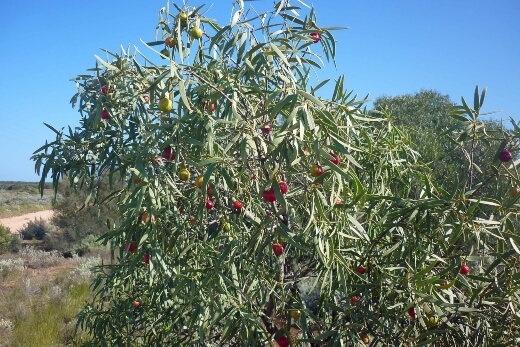
Source: quandongfarm.com
Around the Everard Ranges, the gathering and food preparation of native peach was considered a job for Pitjantjara women. Ripe red fruit would be eaten raw or dried for later use.
The women would collect Sandalwood in bark dishes, separate the edible fruit from the pitted stone, and then roll the fruit into a ball. This fruit ball could then be broken up to be shared by the tribal group.


Get Your Free Guide:
Master Growing Australian Natives eBook
A Must Have Complete Guide for Every Australian Garden
Get Your Free Guide:
Master Growing Australian Natives eBook
A Must Have Complete Guide for Every Australian Garden
On hunting trips, the Pitjabtjara men would eat fresh quandong fruit for energy and fill dishes with a supply to dry and store for use when meat wasn’t available.
The kernels of the sandalwood are 25% protein and 70% complex oils, and these kernels would be used to make antibacterial and anti-inflammatory pastes but also as a form of hair conditioning oil.
Quandong leaves were crushed and mixed with saliva to produce a topical ointment for skin sores and boils.
The early pastoralists of Australia had their own unique uses for the quandong. The men would be away from home for weeks at a time and would often bake damper bread infused with sandalwood leaves.
When in season, the farmers would take their families out for a quandong picnic, which were often the only treats to be enjoyed, especially during the drought and depression years when money was tight.
More recent generations of rural Australians continue with their sandalwood picking traditions, although state laws prohibit the harvesting of wild quandongs.
Naming of the Santalum acuminatum
The name Santalum comes from the Greek word santalon, the Sandalwood tree. Acuminatum comes from the Latin word acuminatus, which means sharp or pointed.
The Santalum acuminatum species was first described by Robert Brown in 1802. He gave the Latin epithet acuminatus to describe the leaves which are pointed.
The botanist Alphonse Pyrame de Candolle gave the current name in 1857, placing it in the genus Santalum which is the genus containing Australian sandalwood.
Popular Quandong Varieties
There are many different quandong varieties, but for the sake of this guide, we’re going to focus on those closest to Santalum acuminatum, and then also the popular Blue quandong.
Santalum lanceolatum (Desert quandong)

Source: commons.wikimedia.org
Santalum lanceolatum is an Australian tree commonly known as desert quandong, northern sandalwood, sandalwood, or true sandalwood and in some areas as burdardu. It has a height range from 1 to 7 metres.
The flowers are green, white, and cream, and bloom between January and October. The species is found throughout central Australia, and becomes more scattered in the southern regions.
Santalum murrayanum (Bitter quandong)

Source: esperancewildflowers.blogspot.com
The bitter quandong produces a bitter fruit, which its common name suggests, and contrasts with Santalum acuminatum, also known as sweet quandong. This shrub or small tree grows to a height of 1 to 5 metres and blooms between October and January, producing white to yellow-green flowers.
You’ll find it on sand plains and dunes, scattered through Western Australia. The fruit is very bitter and inedible.
Elaeocarpus angustifolius (Blue Quandong)
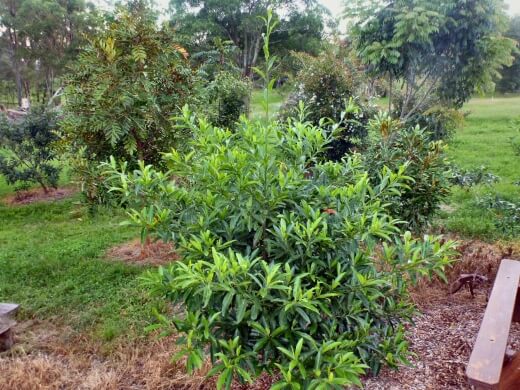
Source: gardeningwithangus.com.au
Blue quandong grows in rainforest and along waterways from north Queensland to northern New South Wales. It is commonly known as white quandong, blue quandong, or silver quandong.
This species of flowering plant is endemic to eastern Australia. It is a large tree with greenish-white flowers and blue fruit, hence the name.
Find out more about the blue quandong and how to use its fruits here.
How to Grow Quandong
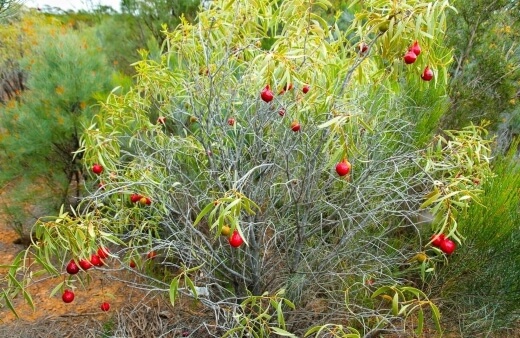
Climate
Sandalwood are drought, frost and salt-tolerant and are well suited to Mediterranean climates - dry summers and cool wet winters.
Best Soil for Quandong
Quandong is able to grow in a range of soil types and soil pH. It seems to thrive however in soils that are nutrient poor and free draining.
The plant doesn’t do well with waterlogging and is susceptible to root diseases if this happens. Lighter textured soils are therefore best for quandong.
Sun Requirements
Quandong favours full sun and in fact needs high light intensity and low humidity.
Watering Schedule
The quandong requires constant watering during its first few years and once established, it can go up to 90 days without any water.
Pruning Quandong
You can prune quandong regularly when the plant is young, cutting back the growing tips of the top and side branches twice a year. This helps the tree to keep a compact and bushy shape.
Make your pruning easier by using the best pruning saw available online.
What Fertiliser to Use
Fertilising is not a must, but any balanced fertiliser at the seedling and then the sapling stage can only be a benefit.
Choosing the right fertiliser can be daunting but our Yates Fertiliser Buying and Reviewing guide can point you in the right direction.
Quandong Propagation
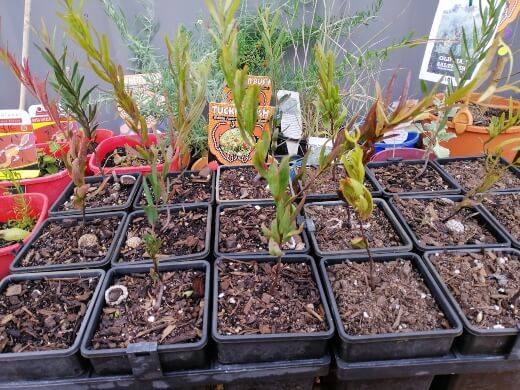
Source: thrivesustainability.com.au
How to Propagate Quandong from seed
You can use either the whole sandalwood seed or kernels. Germination of kernels usually takes about two months but if you use the whole seed, it can take a year or more.
To start, place the seeds or kernels in a pot with holes in the bottom for drainage. Fill a larger container with 1 part household bleach to 9 parts water. Place the pot in it and swirl around until the contents are completely wet, then soak for 30 to 45 minutes.
After soaking, remove the pot and rinse the seeds or kernels thoroughly with cool, boiled water. Place the seed directly in vermiculite in a Zip-lock bag. You can put about 10 in a bag.
Store the bag in a dark cupboard indoors at 15 to 23°C. 18 to 20°C is optimal. Adding some fungicide to the whole seed preparation is suggested.
Inspect the bags after one week and remove any contaminated seed, then continue to check the bags twice weekly and remove germinated seed when the root radical is one cm long.
This takes about 3 weeks for kernels and 2 months for seed. You can then plant the germinated seed directly into the ground or into a pot.
The young sandalwood is quite thirsty and you need to avoid drying out. You want to maintain partial shade, sufficient watering, mulching and protection from strong hot and cold winds until the plant has developed an adequate root system.
(See our in depth guide on mulches and it's different types here.)
Quandongs should be planted as early as possible into their permanent site and the best period is mid-autumn to early spring. The sandalwood sapling needs to be planted within range of at least two potential hosts.
Pot depth and size is important for the tap root system of the quandong as it can grow up to 30 cm long. You want to maintain the root system as close to natural as possible. The smaller the pot, the more care and attention the sandalwood will need when trying to establish it.
You can choose any low-phosphate free-draining potting mix. A potting mix made of peat moss and alkaline sand supplemented with a low-phosphate slow-release fertiliser is perfect.
(In the past, our recommendation included peat/sphagnum moss. But, in light of its environmental implications, we've shifted our focus to more sustainable alternatives that provide equally, if not more, favorable results. Read through our comprehensive guide to explore peat moss and its substitutes.)
Native peach are semi-parasitic plants so a host plant will be beneficial, but it’s not essential. You can use any plant, even an already established one. Choose a plant that’s not going to compete for water and nutrients, something like a native perennial grass, legume, herb, or shrub.
Plant the host plant in the pot first, and once settled, you can add the quandong. If you need some inspiration in finding a host plant for your quandong, have a look at our plant profiles and growing guides.
Quandong Bush Tucker Guide
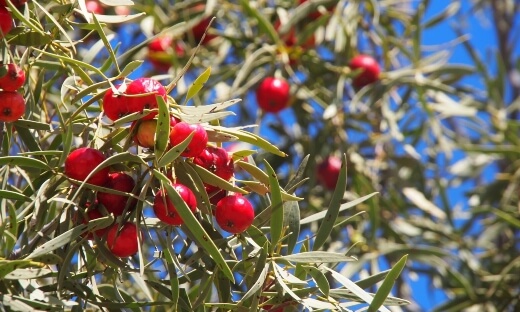
Source: biotiful.sk
Quandong has a sweet taste, with a slightly sour and salty aftertaste and a mild aroma of dry lentils, fermented and earthy. The ripe and textured flesh of the native peach can be eaten fresh, but can also be dried and stored for future use.
The flavour is tart and similar to peach, apricot, or rhubarb. Sandalwood can be used in a range of delicious desserts and is great for making tarts and pies. It also goes well with lemon aspen and muntries.
Santalum acuminatum has many health benefits. It’s a great source of Vitamin E, folate, magnesium and calcium. For those who are vegetarian or vegan, quandongs provide a source of iron and zinc.
When eating this plant, you stock up on antioxidants which boost the immune system, reduce inflammation and protect against diseases including cancer, cardiovascular disease and Alzheimer's disease.
Quandong contains rutin, which works with Vitamin C to strengthen capillaries, reduce dark circles under the eyes and is anti-ageing for skin.
The quandong fruit is commercially available and its distinctive flavour is used as an additive for sweet and savoury foods. It is truly a uniquely Australian product. The kernel of the sandalwood is very high in fats, more than half of the product.
In the past 30 years the native peach has become very popular in Australia's bush food industry. True domestication of the Santalum acuminatum species might take some time though.
For example, the established fruit varieties of apples have been undergoing selection and development for thousands of years. Since 1973, Australia's CSIRO has been doing research into developing improved commercial quandong cultivars.
The aim of this research is to create a good looking bright red quandong, better flesh texture, and a tasty mix of flavours, tannins and food acids. If CSIRO is successful in their quest, the native peach will be only the second Australian food plant species to become domesticated.
Explore more about bush foods and their traditional and modern uses in Australian cuisine.
Native Peach Pests and Diseases to Look Out For
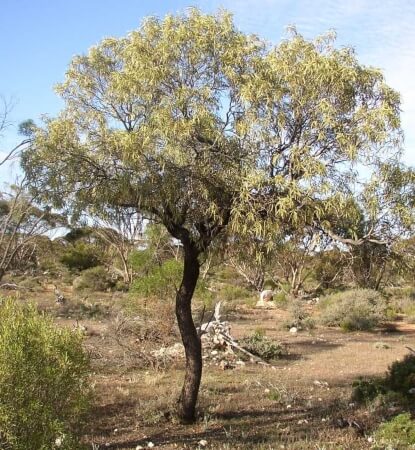
Source: jiggerjuice.info
The quandong moth (Paraepermenia santaliella) is probably the biggest pest to look out for. It damages and reduces fruit and also affects the overall quality.
In terms of dealing with this pest, sanitation is most important and environmentally safe. You need to remove and throw away damaged young fruit throughout the season. This will help reduce future generations of the moth.
The larvae continue to feed inside the fruit after it falls from the tree so removing the fruit quickly does help. Bagging the fruit or creating homemade traps are also effective methods.
There are some other minor pests of the native peach which include caterpillars, scales and mites. These are all usually caused by waterlogging or root rotting diseases.
Here are some tips on how to deal with them:
- Scale – for heavy infestations, you can use warm soapy water and a soft scrubbing brush to remove most of the scale. You can follow this up with an application of an oil based spray like neem oil and repeat as often as needed
- Mites - Dusting sulphur, diatomaceous earth or wood ash can be pressed onto the affected foliage and stems to help control the infestation.
- Caterpillars – you wouldn’t usually worry about a couple of chewed leaves if it means you can enjoy butterflies but you might find these pests making off with more of your plant than you bargained for.
You can inspect the plant and pick off egg clusters and young caterpillars often. You can also apply molasses or chilli sprays to keep them at bay and these are homemade remedies you can make yourself.
Quandong Frequently Asked Questions
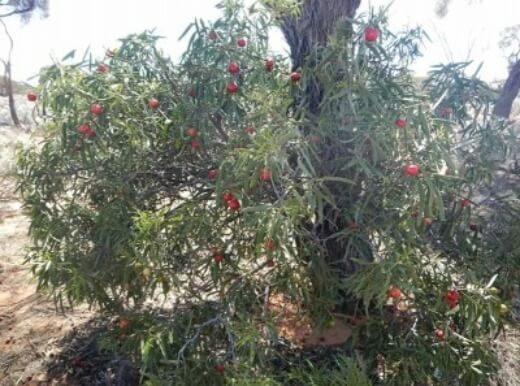
Source: tasteaustralia.biz
How long have quandongs been around?
Fossilised quandongs were actually discovered in the coal seams of Southern Victoria and it’s estimated they date from 40 million years ago.
What is the most common name for the quandong?
Australian people usually call this shrub or tree, Wild Peach, Desert Peach or Native Peach.
Is eating quandong good for you?
Native peach have a vitamin C content higher than oranges so if you need to dose up on some cold and flu fighting superfoods, this is a good start.
How long can you store quandong fruit before you eat it?
Quandong fruit can be dried and frozen for 8 years or more, and it won’t lose any of its flavour in the process.
What can you do with the wood of the quandong tree?
Quandong trees have an aromatic wood and it was in fact used by Aboriginal people in "smoking ceremonies". The wood has a wonderful fragrance when it’s freshly cut and is ideal for cabinet work.
Do quandong seeds have any use?
The seeds can be roasted and they’ve even been compared to almonds. The seeds are often used for jewellery making.
Are you also interested in growing almonds? Check out our comprehensive guide to growing almond trees in Australia.
How much fruit can quandongs produce?
Flowers and fruit are sometimes only produced when the tree is at least seven years old, and sometimes only when the tree is 10 years old.
Harvestable quantities of quandong fruit are produced about four years after planting. A yield of dried fruit can range from about 0.25kg in year four to around 8.25kg in year 15.
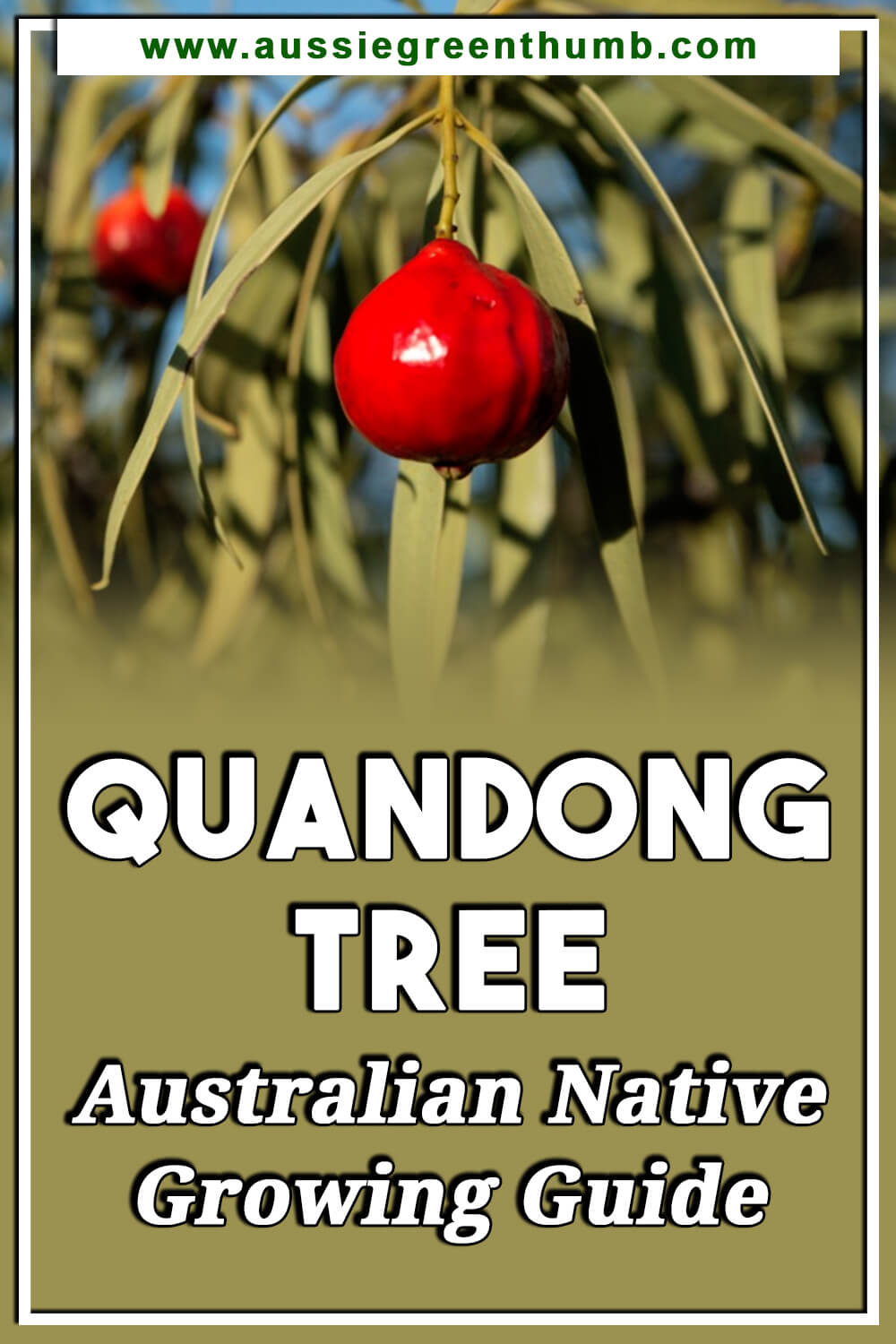
Enjoy Quandong Fruits in Your Garden
Santalum acuminatum is a fruity delight and it’s easy to see why the native peach is an Australian favourite. The Aborigines maximised the tree’s benefits, and enjoyed delicious food, and the best kind of natural first aid kit.
Even today, we understand the love for this divine tart fruit, that is as good as a chutney as it is in a pie. Native peach is nutritious and satisfying, an Australian superfood.
You can easily propagate the kernels and within a few years, enjoy your own stash of ripe red fruit. The shrubby quandong makes for beautiful furniture and jewellery too. Definitely something to invest in for your garden. We’re giving Quandong our green thumbs up.
Published on April 29, 2022 by Nathan Schwartz
Last Updated on January 22, 2025





Some aboriginal friends gave me a potted Quondong and the host plant in the pot was a melalueca of which was much larger than the Quandong seedling but now four year later the Quandong is much larger than the Melaluca and both are in the ground and very happy.
Hi Leslie,
This is amazing, thanks for sharing your success story! Send us over some pictures if you’ve got them, I’d love to see how they’re getting on. The Melaleuca is a gorgeous plant in itself and definitely deserves more attention in our gardens, but having it hosting such a delicious parasite (always sounds weird!) is incredible.
Best regards,
Nathan Schwartz